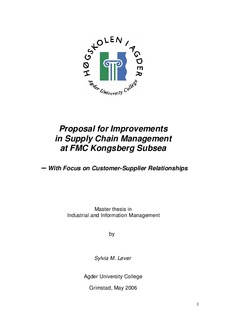| dc.description.abstract | The basis for this master thesis is the principles of Supply Chain Management (SCM) and theoretical approaches to customer-supplier relationships. SCM is a broad management concept addressing the dynamics of supply chains, seeking to manage these in the most optimal manner. Supply chains are value-adding chains of sub-suppliers, suppliers, manufacturers, distributors and end customers, where the success of each participant is to certain degrees dependent on the supply chain as a whole.
The management of supply chains concerns decisions on a strategic level regarding the degree of cooperation among the participants and the organization of transactions. Several different theoretical approaches apply in relation to customer-supplier relationships. The Principal-Agent theory seeks to determine the most efficient contracts when dealing with the agency problem; fear of opportunistic behavior and the existence of different risk preferences in the relationship between the principal (customer) and the agent (supplier). This is closely related to the division of power and dependency in such relationships. The Transaction Cost theory addresses costs related to market-oriented transactions between customers and suppliers; and seeks to guide managers in their effort to organize in an optimal manner; make or buy. Thus, the Transaction Cost theory perspective discusses an either marked-based or hierarchic approach to customer-supplier relationships. The Network Based perspective introduces a network-oriented type of relationship, in between market-based and hierarchic, which is not included in the Transaction Cost theory perspective. Network-oriented relationships are characterized by trust and long-term commitment between independent actors, suggesting that firms that connect to their networks with embedded ties have greater chances of survival than firms that connect to their networks with arms-length ties. The Resource-Based theory perspective introduces another approach to the make-or-buy question; focusing on a company’s core competence, implying that corporate managers should look inward and consider what they do best as opposed to trying to do everything for their current customers.
Further, Porter’s Five Forces model describes the rules of competition in traditional customer-supplier relationships (competitive relationships where both parts try to reduce the others position of power as there is a game of win or loose). The rules of competition are embodied in five competitive forces; the entry of new competitors, the threat of substitutes, the bargaining power of buyers, the bargaining power of suppliers, and the rivalry among existing competitors. The contrast to traditional customer-supplier relationships is partnership-based relationships; when customers and suppliers enter a partnership where both parties play a win-win game. Together they try to increase the total competitiveness of the entire supply chain and thereby also increase the total profit margin. Commitment, trust and long-time aspects are key words in this type of relationship. Further, the parties should be mutually dependent, and the partnership approach should be a part of both parties’ strategies
The management of supply chains is concerned with building the most optimal supply chains. Supply chain optimization can be described as the coordination of linked resources across all or parts of a supply chain to build the most efficient supply chains. Lack of leadership vision, poor customer relationship management and lack of trust and collaboration across the supply chain are some of the obstacles in seeking to achieve this.
Kraljic’s portfolio approach provides strategic approaches to customer-supplier relationships by classifying suppliers based their products’ significance for the customer, implying closer relationships the higher the product significance and lower product availability in the market. In relation to FKS, this concerns the question of how strategic approaches to suppliers and supplier handling are identified.
Thus, the research questions of this master thesis included the following aspects: (1) How does FKS organize the handling of suppliers?; (2) Where are the main weaknesses in FKS’ supplier handling?; (3) Which methods are suitable to improve FKS’ supplier handling?; and (4) Which actions could a SCM improvement project consist of for FKS?
The FKS Procurement Process describes how FKS is carrying out its processes for the planning of purchases, establishment of contracts, production, logistics, strategic procurement, and supplier development. The FKS process principally consists of the steps of the procurement life cycle.
Regarding strategic approaches to supplier, FKS has not formally classified their suppliers by the principles of Kraljic’s portfolio approach, but the criteria that have been identified for determining eventual establishments of frame and partnering agreements are closely related to Kraljic’s classification method. In this sense, frame or partnering agreements are or will be established with suppliers of high significance for FKS (in relation to spend, capacity, degree of specialized products etc.) to secure compliance with future demand. Simplified procurement is established with suppliers of more standardized products.
Root Cause Analysis has been the method for performing the empirical investigation and analysis to determine the main weaknesses in FKS’ supplier handling. This method includes (1) Problem identification and description, (2) Determination of possible causes, (3) Cause verification, and finally (4) Solution development. Problem identification and description concerned identifying and describing improvement areas in the relationship between FKS and their suppliers. This was done through interviews of FKS employees and selected suppliers based on the established interview guide. Further, brainstorming (also with FKS employees and selected suppliers) provided the identification and verification of possible root causes, as well as possible solutions.
Identified improvement areas in the relationships between FKS and their suppliers are primarily based on the need for increased training of FKS employees and suppliers, clarification of roles and responsibility, establishment and implementation of distinct strategies regarding supplier handling (including closer cooperation with strategic suppliers), and systematic approach to pro-active supplier development. In this regard, this master thesis may contribute to the development of strategies based on theoretical approaches to supply chain management and supply chain participants’ behavior. This is related to the organization of the supply base (determining market- or network-oriented approaches), and how to protect relationships with suppliers through the establishment of contracts. Further, the solutions and actions that have been proposed (page 89) are aimed at directly addressing the current challenges in the relationships between FKS and their suppliers. | en |
